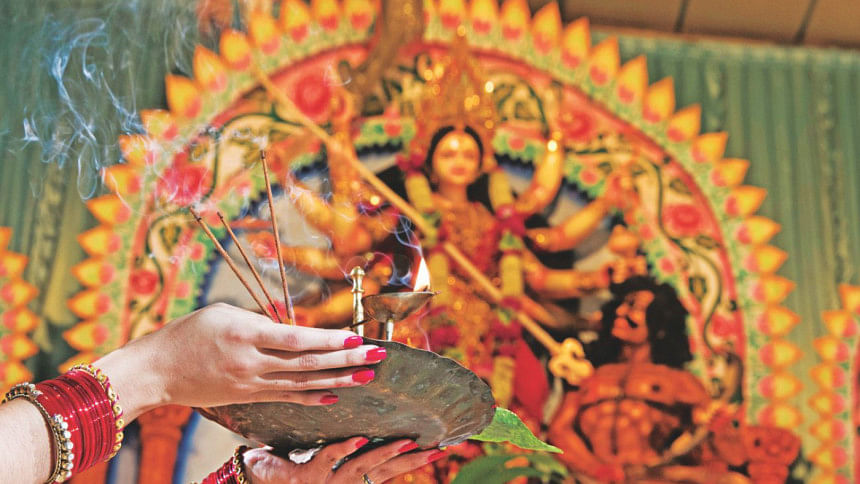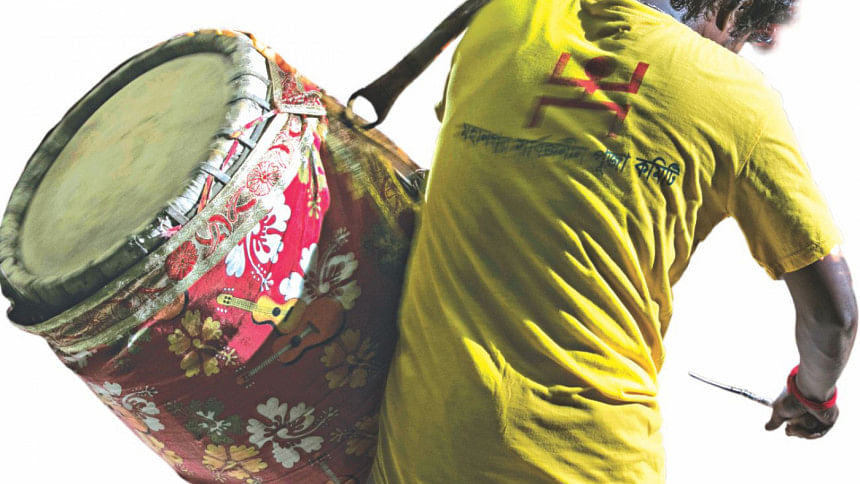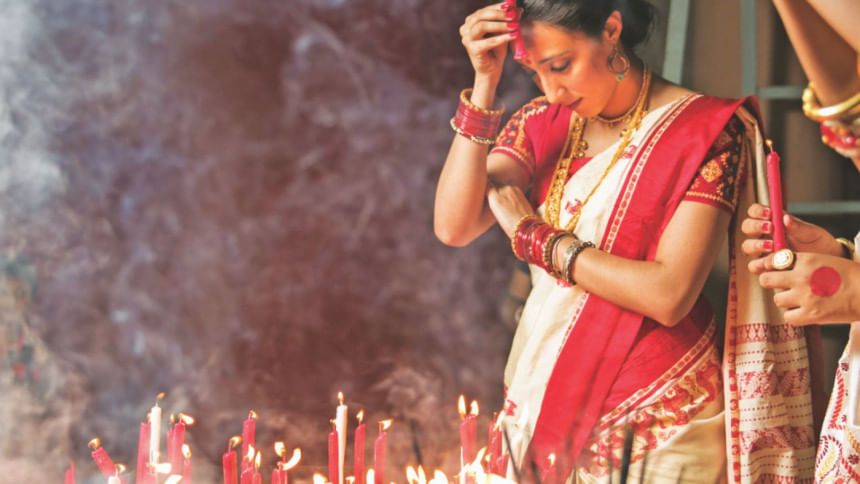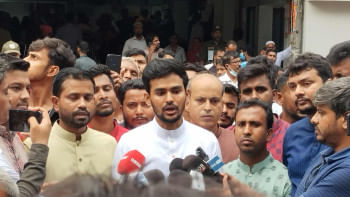Theatrics of the divine (video)

The dhakis started beating their dhaks; slowly and gently, as if they were politely calling the priest to perform the arati, a ritualistic form of worship that is practised after the main puja. Clad in a white dhoti and a fatua, he was sitting crossed-legged, in front of the idol of Durga, with a myriad of curious objects laid on the floor.
The dhakis play their instrument, dhak, which is a type of drum. With the maddening beats, they bring about a festive and energised atmosphere during arati.
As if due to the impatience of the dhakis, he got up. It was time for him to perform. The stage was ready. The audience too, eagerly looked on.
Behind him lay a massive crowd of devotees. But the veteran priest, through decades of performance, knows well who his real audience is. It was not those who were behind him.

It was rather those who were in front - the gods and the goddesses. They were his audience. He was doing the arati to entertain and please them, to earn their blessings.
The dhakis sped up their beats, excited that the event had finally begun. The priest - calm, quiet, composed - stared at Mother Durga. Her beautiful face. Her numerous hands. Her weapons. The fierce lion – her ride.
Facing each other, the priest seemed insignificant in front of her - a mere mortal in the presence of the eternal.
He had a ghonta (bell) on the left hand and a dhoopti on the other. The constant ringing of the small, but powerful bell added to the rhythmic beating of the dhaks.
He put his right hand forward, almost as if offering the dhoopti to the goddess. He began to move his hand in a circular motion. The dhoopti, with coconut husk burning inside, arouse dhoop (smoke). Thick, white smoke snaked upwards, and with the circular motion, was all around the idol and the priest. The beautiful fragrance of the dhoop quickly filled the air, invigorating everyone all around.

The priest eventually turned to them and the handed over the dhoopti. The devotees cupped their hands over it and then raised their palms to their forehead, receiving blessings of the goddess.
Meanwhile, the priest picked up another object: pradeep. Five pradeeps, actually - compiled and fixed in a holder. To please deities, there are rules to be followed. The priest could have also taken a single pradeep or a holder containing 108 pradeeps. 1, 5 or 108. Not more, not less. No in-betweens.
Fire illuminated the goddess further as the priest continued his ritualistic circular motions of the hand. And then, he handed it out to the devotees for them to receive blessings.

He picked up another object: a shonkho. After the element of fire, came a conch shell filled with water. Shonkho is cool. Shonkho is calm. Shonkho is pure. He continued to move his hand in circles.
The ringing of the bell continued tirelessly. The dhakis reached a state of frenzy, beating their loud instruments with passionate intensity. The devotees looked on. So did the 'audience'.
On the stage, the priest replaced the shonkho with boshro - the fabric. He waved a handkerchief in front of the goddess.

By then, a lot of time had elapsed. But the ringing of the bell continued. The dhakis seemed to reach a new height of trance with every object that was been picked up. Nobody had any intention of quitting.
The priest too, did not show any sign of fatigue. In fact, his face showed absolutely nothing. He was in deep meditation. His sole focus was on his audience and the rites to please them. The only way one could tell that he was still in this world and had not left it to join the deities themselves was the involuntary shaking of his knees - and the jerky movements of his hand while it went on circles - with the beats of the dhaks. His body moved with the rhythm of the beats. But his face was like a stone, hinting no emotions whatsoever

One prop after another. Flowers came next. Maa loves red flowers. So the priest offered some, along with 'bael' leaves. Durga's consort is Shiva, who is believed to admire bael leaves. And Durga is not alone in the audience. She is accompanied by her family. Therefore, the performer tries to please them as well.
Chamor, a fur, was next. And then came the last item on the list: pankha. The priest waved his hand around the idol with the peacock fan.
Arati seems to use all the elements that are to be found, that the world is composed of, be it fire, air, water, earth, etc.

The performance was reaching an end. The dhakis put all their remaining energy into their instruments. The deafening noise reached its climax. And then, with several last slaps on the drum, the music came to a halt. The bell, too, was put to rest.
The priest then brought the conch to his mouth and blew. The mighty and heavenly sound of the shell trumpet brought the arati to an end.
The sound that had lasted for a long time had numbed the ears. But that is a small and temporary price to pay, given the excitement and more importantly, the blessings, bestowed by the deities.


he priest again assumed his position: cross-legged on the floor. He had maintained his composure all throughout. And, as if nothing happened, or having no recollection of the breathtaking and taxing performance he just delivered, continued to mind his own business. This time, it was attending to the people - chitchats, blessings, etc.
Such is the experience of this theatre. While it has similar notions of a regular theatre, it is an extraordinary one. For it is the theatre dedicated to gods and goddesses. It is where the theatrics are of the divine, for the divine.

By M H Haider
Special thanks to Jyatish Chakrabatry, who has been a priest for about 25 years in different temples. Photo: Sazzad Ibne Sayed
Model: Meghla, Hridi and Sudeshna Swayamprabha
Make-up: Farzana Shakil
Wardrobe Meghla and Hridi : Aarong
Special thanks to Kajol Debnath, President Bangladesh Puja Udjapan Parishad and Sharmila Banerjee for arranging the photo shoot
Check out Lifestyle's facebook page for the video shoot!

 For all latest news, follow The Daily Star's Google News channel.
For all latest news, follow The Daily Star's Google News channel. 



Comments